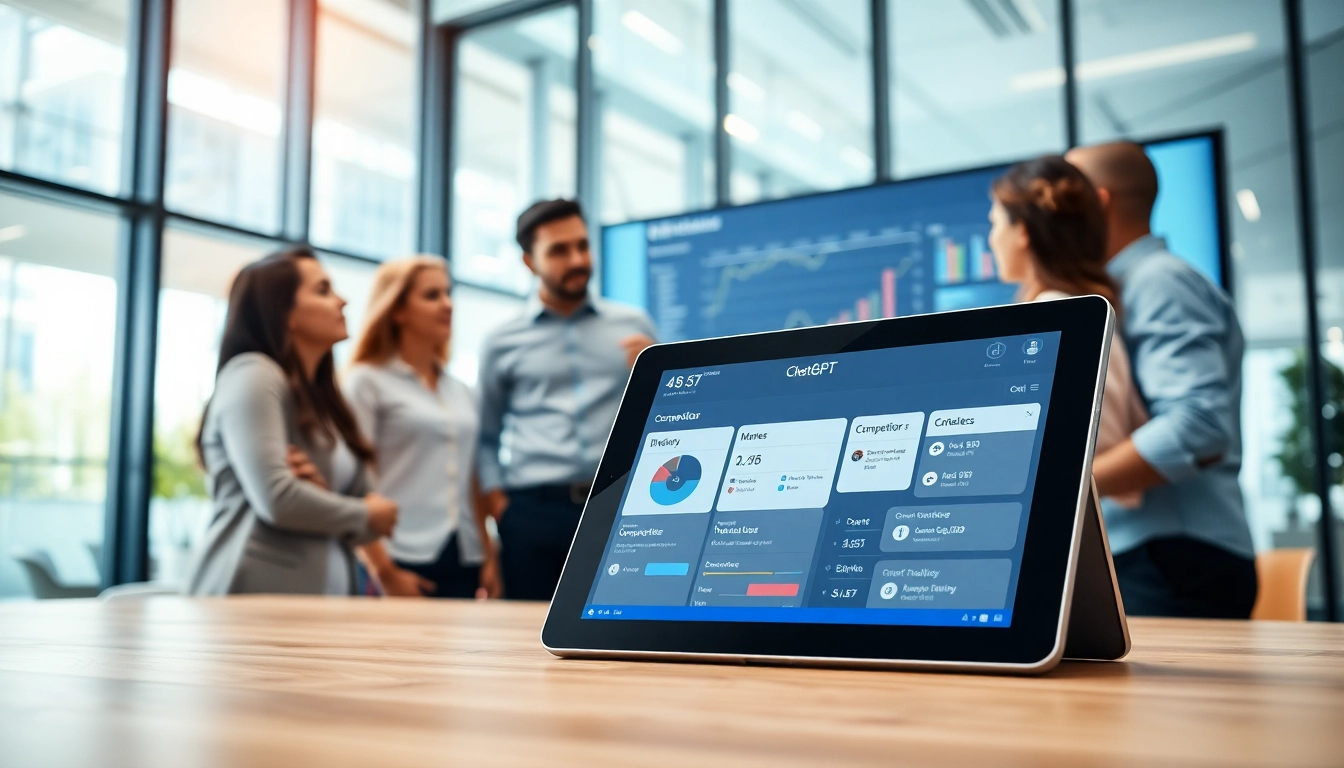Understanding Competitor Analysis with AI Prompts
In today’s highly competitive market landscape, understanding your competitors is not just advantageous; it is essential. Companies need to actively assess not only their competition but also the broader market dynamics to make informed strategies. One of the most revolutionary developments in this space is the incorporation of artificial intelligence in competitor analysis, particularly through tools like ChatGPT. Employing ai prompts for competitor analysis can streamline this process, allowing organizations to extract actionable insights efficiently.
What is Competitor Analysis?
Competitor analysis involves evaluating your competitors to understand their strengths, weaknesses, strategies, and market positions. Typically, this involves assessing various aspects such as product offerings, pricing strategies, marketing approaches, and customer service. The ultimate goal is to identify opportunities and threats within your market space, enabling you to develop effective strategies to enhance your competitive edge.
A well-rounded competitor analysis looks beyond mere statistical data and dives deep into qualitative factors such as customer perceptions, brand loyalty, and market positioning. It serves as a foundation for strategic decision-making, helping businesses navigate the complexities of market trends and shifts.
Importance of AI in Competitor Analysis
Artificial Intelligence has transformed how businesses approach competitor analysis. Traditional methods often required extensive manual research, which was not only time-consuming but also prone to human error. AI streamlines this process by analyzing large sets of data quickly and efficiently, providing precise insights.
For instance, AI can assist in identifying patterns in consumer behavior, pinpointing market gaps, and tracking changes in competitors’ strategies in real-time. This level of data processing and insight extraction allows companies to be proactive rather than reactive, positioning them ahead of competitors in critical decision-making times.
Overview of ChatGPT for Marketing and Strategy
ChatGPT, developed by OpenAI, has found various applications in marketing and strategy formulation. As a conversational AI model, it can be utilized to generate insights and provide suggestions that are based on historical data and market trends. Businesses can leverage ChatGPT to probe questions about their competitive landscape effectively.
Whether it’s identifying competitor strengths or evaluating customer feedback, ChatGPT provides a level of versatility and scalability unmatched by traditional methods. Users can simply input prompts, and the AI will deliver comprehensive analyses, reports, or actionable strategies based on the queried information.
Effective AI Prompts for Competitor Research
Generating Market Insights with AI
To extract meaningful insights, businesses can employ specific AI prompts designed to reveal critical market intelligence. Here are a few examples:
- Market Gap Identification: “Analyze the current trends in [industry] and identify emerging opportunities that competitors have not yet capitalized on.”
- Competitor Engagement: “List the top strategies being implemented by [competitor name] in their marketing campaigns and their corresponding results.”
- Consumer Sentiment Analysis: “Assess customer reviews for [competitor] and summarize the key points of satisfaction and dissatisfaction.”
Using these prompts helps companies make informed decisions about where to allocate resources, which can significantly impact their competitive advantage.
Prompts for SWOT Analysis of Competitors
Conducting a SWOT (Strengths, Weaknesses, Opportunities, Threats) analysis is paramount to understanding how your competitors stack up against you. Prompts to facilitate this process include:
- Strengths Exploration: “Identify the main strengths of [competitor name] in product offerings and customer loyalty.”
- Weaknesses Inquiry: “What weaknesses have been highlighted by customers in reviews of [competitor]?”
- Opportunity Detection: “What trends and shifts in consumer preferences can [company name] leverage to outmaneuver [competitor]?”
- Threat Assessment: “List external factors that could pose a threat to [competitor name]’s market share in the next 1-2 years.”
This framework empowers businesses to visualize the competitive landscape, allowing them to craft robust strategies that leverage unique strengths and address potential weaknesses.
Identifying Niche Opportunities Using AI
Another significant advantage of leveraging AI in competitor analysis is its potential to identify niche markets. Through careful prompt crafting, companies can ask AI to find segments that remain underserved or entirely overlooked. Consider the following examples:
- Market Segmentation: “What niche customer segments within [industry] have low competition but high demand?”
- Emerging Trends: “Identify emerging consumer behaviors in [industry] that competitors have not yet responded to.”
Using AI to uncover these opportunities can lead to innovative product development and marketing strategies that resonate with specific consumer needs, thereby providing a competitive edge.
Comparative Analysis Techniques Using AI
Product Feature Comparisons
Product feature comparisons are essential to understanding the competitive advantages and disadvantages your products hold. AI can help generate insights based on various feature sets offered by competitors. Prompts that can aid this analysis include:
- Feature Inventory: “Compare the key features of [your product] with [competitor’s product]. Highlight differences and unique offerings.”
- Consumer Preferences: “What product features do customers prioritize when choosing between [your brand] and [competitor]?”
Such insights can guide product development decisions, ensuring offerings are aligned with consumer desires while also standing out against competitors.
Pricing Strategy Analysis
Understanding competitors’ pricing strategies is crucial for effective positioning and sales strategies. Companies can leverage AI to gain insights through targeted prompts like:
- Price Positioning: “Analyze the pricing strategies of [competitor names] for similar products and recommend adjustments for our pricing model.”
- Promotional Strategies: “Assess the effectiveness of [competitor]’s promotions and discounts and suggest improvements.”
These analyses aid companies in developing competitive pricing strategies that attract customers while maintaining profitability.
Marketing Strategy Evaluation
Marketing strategy evaluation through AI involves assessing how competitors promote their products and position their brands. Insights can be gained from prompts such as:
- Campaign Effectiveness: “What are the most successful marketing campaigns by [competitor name] in the past year? Analyze their approach and results.”
- Content Evaluation: “Identify the types of content that engage customers most effectively in [competitor’s] marketing strategy.”
By dissecting successful marketing strategies of competitors, companies can adopt best practices and innovate on their tactics, enhancing their market visibility.
Implementing Insights Gained from AI Prompts
Steps to Developing an Actionable Competitive Strategy
Transforming insights gained from AI analysis into actionable strategies requires a structured approach:
- Data Consolidation: Gather all insights collected from AI prompts and categorize them based on their relevance.
- Strategic Objective Definition: Define clear objectives based on the insights that align with your overall business goals.
- Tactical Planning: Develop a tactical plan outlining how to implement the strategies derived from insights, including timelines and assigned responsibilities.
- Performance Metrics Setup: Establish performance metrics to assess the effectiveness of the implemented strategies.
Using Insights for Product Development
AI-driven insights can significantly influence product development by ensuring new features or products directly meet consumer demand. Implementation involves:
- Feedback Loop Creation: Utilize customer feedback gathered through AI to inform product iteration.
- Prototype Testing: Develop prototypes of newly conceived features/products and utilize consumer insights to guide improvements before full launch.
- Market Testing: Conduct A/B testing with different segments to refine offerings based on measurable responses.
Engaging in product development through an iterative process based on data-driven insights bolsters market fit and consumer satisfaction.
Measuring the Impact of AI-Driven Analysis
To validate the effectiveness of the strategies derived from AI analysis, organizations should establish robust measurement frameworks. Steps include:
- Key Performance Indicators (KPIs): Define KPIs aligned with organizational objectives to monitor the impact of competitor analysis-driven strategies.
- Regular Reviews: Conduct regular reviews to evaluate progress, making necessary adjustments based on performance data.
- Long-term Analysis: Understand the long-term impact of changes made; are they sustainable, and do they align with shifting market dynamics?
By closely monitoring the results of implemented strategies, businesses can refine their approach to ensure ongoing competitiveness.
Future Trends in AI-Powered Competitive Analysis
Advancements in AI Technology for Market Analysis
The future of AI in market analysis holds substantial promise. With rapid advancements in machine learning models and data processing capabilities, businesses can expect to gain even deeper insights than currently available. Predictive analytics, enhanced natural language processing, and more sophisticated sentiment analysis tools are expected to emerge, providing even more accurate market assessments.
Anticipated Changes in Competitor Strategies
As AI technology becomes more integrated into the market analysis spectrum, competitor strategies will likely evolve in response. Companies may begin to adopt more aggressive data-sharing configurations and partnerships to remain competitive. Enhanced agility and adaptability in strategy formulation, based on AI-derived consumer insights, will become essential for success.
Preparing for Evolving Market Dynamics
To thrive in the future landscape of AI-powered competitive analysis, businesses need to stay ahead of analytics trends. Investments in continuous learning and development, culture fostering innovation, and agile responses to market changes will enhance resilience. Understanding the implications of AI advancements on consumer behavior and market trends will ensure long-term sustainability in rapidly changing environments.















Leave a Reply